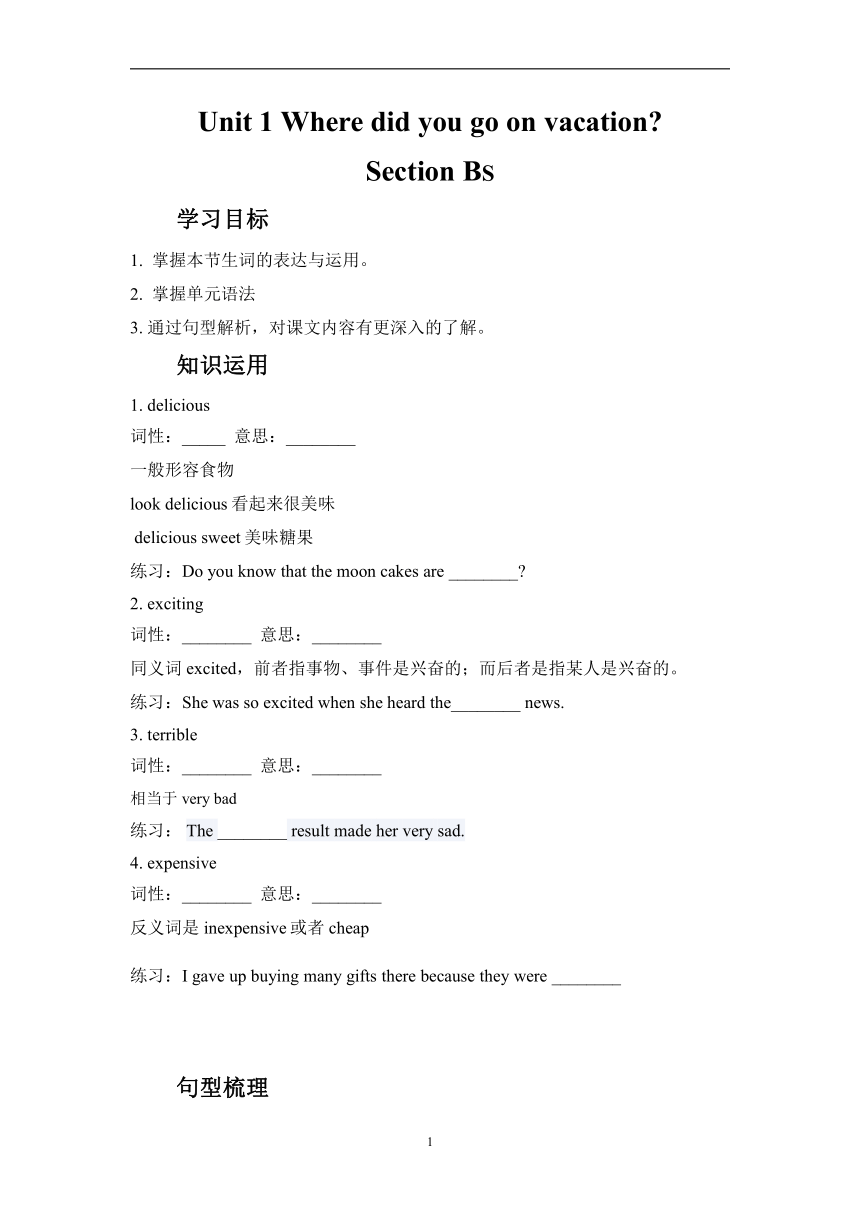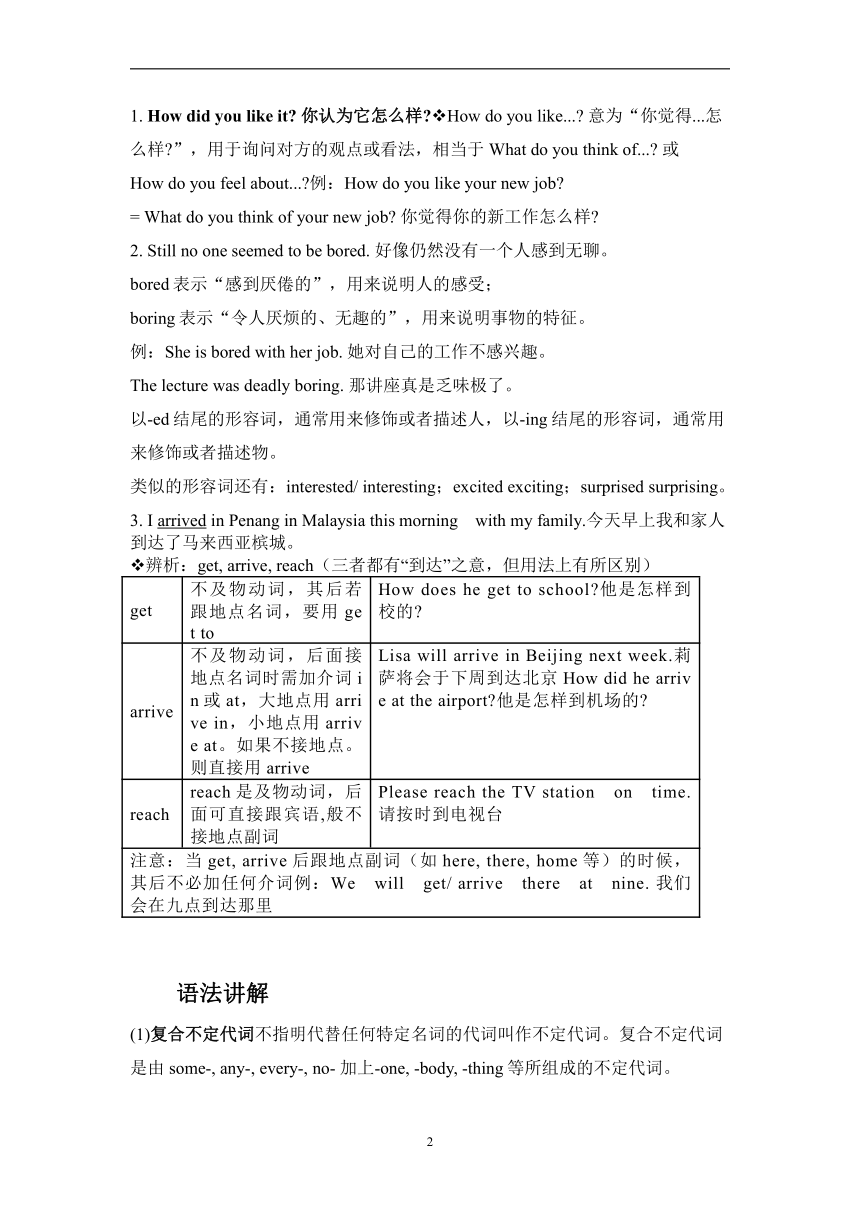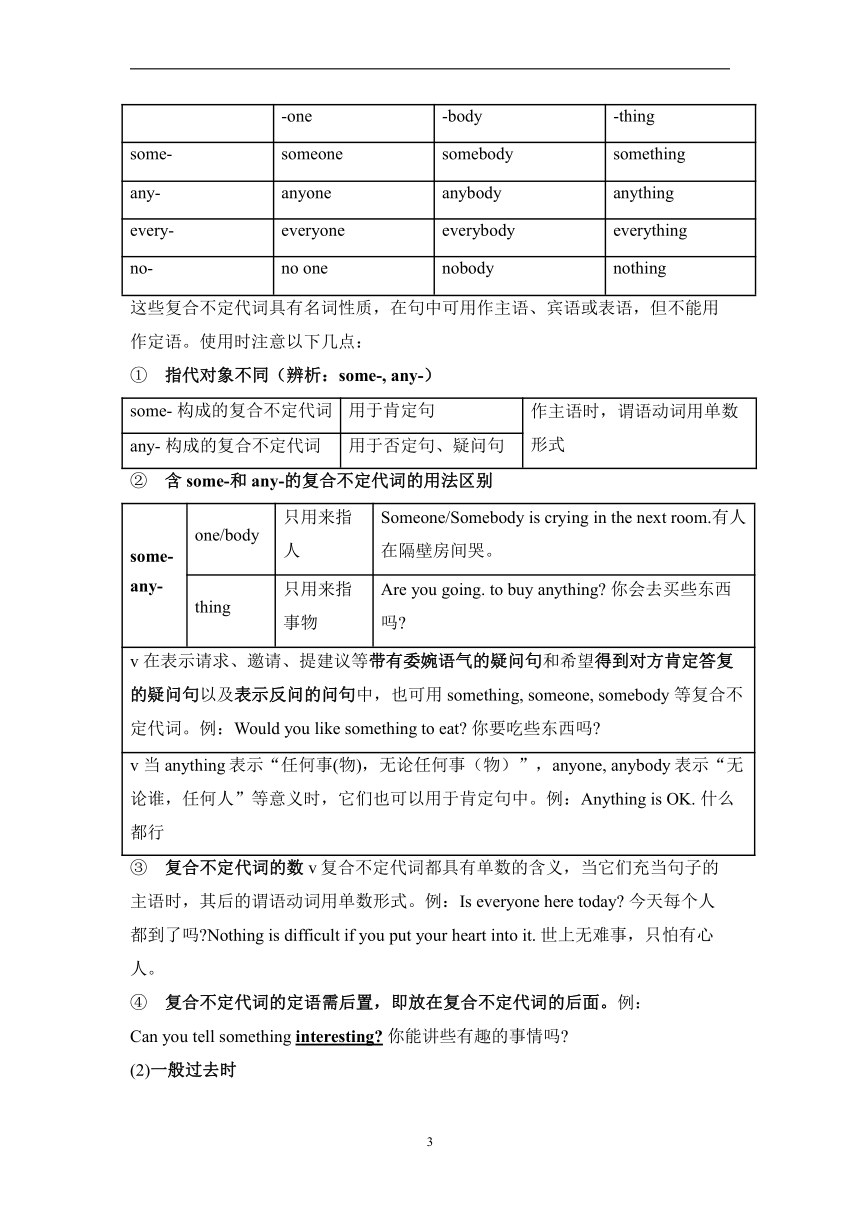Unit 1 Where did you go on vacation Section B 1a-3c 学案
文档属性
| 名称 | Unit 1 Where did you go on vacation Section B 1a-3c 学案 |  | |
| 格式 | docx | ||
| 文件大小 | 31.4KB | ||
| 资源类型 | 教案 | ||
| 版本资源 | 人教新目标(Go for it)版 | ||
| 科目 | 英语 | ||
| 更新时间 | 2023-10-27 22:44:19 | ||
图片预览



文档简介
Unit 1 Where did you go on vacation
Section BS
学习目标
掌握本节生词的表达与运用。
掌握单元语法
3. 通过句型解析,对课文内容有更深入的了解。
知识运用
1. delicious
词性:_____ 意思:________
一般形容食物
look delicious看起来很美味
delicious sweet美味糖果
练习:Do you know that the moon cakes are ________
2. exciting
词性:________ 意思:________
同义词excited,前者指事物、事件是兴奋的;而后者是指某人是兴奋的。
练习:She was so excited when she heard the________ news.
3. terrible
词性:________ 意思:________
相当于very bad
练习: The ________ result made her very sad.
4. expensive
词性:________ 意思:________
反义词是inexpensive或者cheap
练习:I gave up buying many gifts there because they were ________
句型梳理
1. How did you like it 你认为它怎么样 How do you like... 意为“你觉得...怎么样 ”,用于询问对方的观点或看法,相当于What do you think of... 或How do you feel about... 例:How do you like your new job = What do you think of your new job 你觉得你的新工作怎么样
2. Still no one seemed to be bored. 好像仍然没有一个人感到无聊。
bored表示“感到厌倦的”,用来说明人的感受;
boring表示“令人厌烦的、无趣的”,用来说明事物的特征。
例:She is bored with her job. 她对自己的工作不感兴趣。
The lecture was deadly boring. 那讲座真是乏味极了。
以-ed结尾的形容词,通常用来修饰或者描述人,以-ing结尾的形容词,通常用来修饰或者描述物。
类似的形容词还有:interested/ interesting;excited exciting;surprised surprising。
3. I arrived in Penang in Malaysia this morning with my family.今天早上我和家人到达了马来西亚槟城。
辨析:get, arrive, reach(三者都有“到达”之意,但用法上有所区别)
get 不及物动词,其后若跟地点名词,要用get to How does he get to school 他是怎样到校的
arrive 不及物动词,后面接地点名词时需加介词in或at,大地点用arrive in,小地点用arrive at。如果不接地点。则直接用arrive Lisa will arrive in Beijing next week.莉萨将会于下周到达北京How did he arrive at the airport 他是怎样到机场的
reach reach是及物动词,后面可直接跟宾语,般不接地点副词 Please reach the TV station on time.请按时到电视台
注意:当get, arrive后跟地点副词(如here, there, home等)的时候,其后不必加任何介词例:We will get/ arrive there at nine. 我们会在九点到达那里
语法讲解
(1)复合不定代词不指明代替任何特定名词的代词叫作不定代词。复合不定代词是由some-, any-, every-, no- 加上-one, -body, -thing等所组成的不定代词。
-one -body -thing
some- someone somebody something
any- anyone anybody anything
every- everyone everybody everything
no- no one nobody nothing
这些复合不定代词具有名词性质,在句中可用作主语、宾语或表语,但不能用作定语。使用时注意以下几点:
① 指代对象不同(辨析:some-, any-)
some- 构成的复合不定代词 用于肯定句 作主语时,谓语动词用单数形式
any- 构成的复合不定代词 用于否定句、疑问句
② 含some-和any-的复合不定代词的用法区别
some-any- one/body 只用来指人 Someone/Somebody is crying in the next room.有人在隔壁房间哭。
thing 只用来指事物 Are you going. to buy anything 你会去买些东西吗
v 在表示请求、邀请、提建议等带有委婉语气的疑问句和希望得到对方肯定答复的疑问句以及表示反问的问句中,也可用something, someone, somebody 等复合不定代词。例:Would you like something to eat 你要吃些东西吗
v 当anything表示“任何事(物),无论任何事(物)”,anyone, anybody表示“无论谁,任何人”等意义时,它们也可以用于肯定句中。例:Anything is OK. 什么都行
③ 复合不定代词的数v复合不定代词都具有单数的含义,当它们充当句子的主语时,其后的谓语动词用单数形式。例:Is everyone here today 今天每个人都到了吗 Nothing is difficult if you put your heart into it. 世上无难事,只怕有心人。
④ 复合不定代词的定语需后置,即放在复合不定代词的后面。例:Can you tell something interesting 你能讲些有趣的事情吗
(2)一般过去时
① 一般过去时的用法一般过去时用来描述过去发生的动作或存在的状态。常和一般过去时搭配的标志性的时间状语有yesterday, last week, in the past等。例:They stayed at home yesterday. 昨天他们待在家里。
② 一般过去时的三种句式结构:
含be动词 主语+was/ were+表语 They were very happy. 他们很开心。
There be句型 There was/ were+主语+地点状语 There was a farm near here two years ago.两年前这儿附近有一个农场。
含行为动词 主语+行为动词的过去式+其他 The students went to the farm yesterday.昨天学生们去农场了。
③ 一般过去时的句式变化vbe动词的一般过去时的句式变化
肯定句 主语+was/were+表语 We were at home yesterday. 昨天我们在家。
否定句 主语+wasn’t/weren’t+表语 We weren’t at home yesterday. 昨天我们不在家。
一般疑问句 Was/Were+主语+表语? Were you at home yesterday 昨天你们在家吗
肯定答语 Yes,主语+was/were. —Yes, we were. 是的,我们在家。
否定答语 No,主语+ wasn’t/ weren’t. —No, we weren’t. 不,我们不在家。
there be句型的一般过去时的句式变化:
肯定句 There was/ were+主语+地点状语. There were some trees in the village five years ago.五年前这个村庄有一些树。
否定句 There wasn’t/ weren’t+主语+地点状语. There weren’t any trees in the village five years ago.五年前这个村庄没有树。
一般疑问句 Was/Were there+主语+地点状语 Were there any trees in the village five years ago 五年前这个村庄有树吗
肯定答语 Yes, there was/were. —Yes, there were. 是的,有。
否定答语 No, there wasn’t/ weren’t. —No, there weren't. 不,没有。
行为动词的一般过去时的句式变化
肯定句 主语+动词的过去式+其他. We went to the museum last week. 上周我们去博物馆了。
否定句 主语+didn't+动词原形+其他. We didn’t go to the museum last week. 上周我们没有去博物馆。
一般疑问句 Did+主语+动词原形+其他 Did you go to the museum last week 上周你们去博物馆了吗
肯定答语 Yes, 主语+did. —Yes, we did. 是的,我们去了。
否定答语 No, 主语+didn't. —No, we didn’t. 不,我们没有去。
④ 动词的过去式的变化规律包括规则变化和不规则变化两种。v规则变化通常以-ed结尾。具体如下:
构成规则 举例
一般情况下动词原形末尾加-ed help—helped
结尾是e的动词加-d Live—lived
以重读闭音节结尾,且末尾只有一个辅音字母的动词,先双写这个辅音字母,再加-ed stop—stoppedplan—planned
结尾是“辅音字母+y”的动词,先变y为i再加-ed carry—carried;study—studied
(3)一般过去时(II)侧重行为动词的一般过去时的特殊疑问句
① 对人物进行提问时有两种情况:
如果人物作主语 Who+行为动词的过去式+其他 Who cleaned our classroom yesterday 昨天谁打扫了我们的教室
如果人物作宾语 Who/Whom+ did+主语+动词原形+其他 Who did you go with 你和谁一起去的
② 对事件、时间、地点、方式等进行提问时,结构为:特殊疑问词+did+主语+动词原形+其他 vWhat did he do last night 昨天晚上他做什么了 (事件)vWhen did you meet Lisa 你是什么时候遇到莉萨的 (时间)vWhere did you go last weekend 上周末你们去哪里了 (地点)vHow did you get to Beijing 你是怎么到北京的 (方式)vWhy did you want to visit China 你为什么想去游览中国 (原因)
答案
知识运用
1. delicious 2. exciting 3. terrible 4. expensive
2
Section BS
学习目标
掌握本节生词的表达与运用。
掌握单元语法
3. 通过句型解析,对课文内容有更深入的了解。
知识运用
1. delicious
词性:_____ 意思:________
一般形容食物
look delicious看起来很美味
delicious sweet美味糖果
练习:Do you know that the moon cakes are ________
2. exciting
词性:________ 意思:________
同义词excited,前者指事物、事件是兴奋的;而后者是指某人是兴奋的。
练习:She was so excited when she heard the________ news.
3. terrible
词性:________ 意思:________
相当于very bad
练习: The ________ result made her very sad.
4. expensive
词性:________ 意思:________
反义词是inexpensive或者cheap
练习:I gave up buying many gifts there because they were ________
句型梳理
1. How did you like it 你认为它怎么样 How do you like... 意为“你觉得...怎么样 ”,用于询问对方的观点或看法,相当于What do you think of... 或How do you feel about... 例:How do you like your new job = What do you think of your new job 你觉得你的新工作怎么样
2. Still no one seemed to be bored. 好像仍然没有一个人感到无聊。
bored表示“感到厌倦的”,用来说明人的感受;
boring表示“令人厌烦的、无趣的”,用来说明事物的特征。
例:She is bored with her job. 她对自己的工作不感兴趣。
The lecture was deadly boring. 那讲座真是乏味极了。
以-ed结尾的形容词,通常用来修饰或者描述人,以-ing结尾的形容词,通常用来修饰或者描述物。
类似的形容词还有:interested/ interesting;excited exciting;surprised surprising。
3. I arrived in Penang in Malaysia this morning with my family.今天早上我和家人到达了马来西亚槟城。
辨析:get, arrive, reach(三者都有“到达”之意,但用法上有所区别)
get 不及物动词,其后若跟地点名词,要用get to How does he get to school 他是怎样到校的
arrive 不及物动词,后面接地点名词时需加介词in或at,大地点用arrive in,小地点用arrive at。如果不接地点。则直接用arrive Lisa will arrive in Beijing next week.莉萨将会于下周到达北京How did he arrive at the airport 他是怎样到机场的
reach reach是及物动词,后面可直接跟宾语,般不接地点副词 Please reach the TV station on time.请按时到电视台
注意:当get, arrive后跟地点副词(如here, there, home等)的时候,其后不必加任何介词例:We will get/ arrive there at nine. 我们会在九点到达那里
语法讲解
(1)复合不定代词不指明代替任何特定名词的代词叫作不定代词。复合不定代词是由some-, any-, every-, no- 加上-one, -body, -thing等所组成的不定代词。
-one -body -thing
some- someone somebody something
any- anyone anybody anything
every- everyone everybody everything
no- no one nobody nothing
这些复合不定代词具有名词性质,在句中可用作主语、宾语或表语,但不能用作定语。使用时注意以下几点:
① 指代对象不同(辨析:some-, any-)
some- 构成的复合不定代词 用于肯定句 作主语时,谓语动词用单数形式
any- 构成的复合不定代词 用于否定句、疑问句
② 含some-和any-的复合不定代词的用法区别
some-any- one/body 只用来指人 Someone/Somebody is crying in the next room.有人在隔壁房间哭。
thing 只用来指事物 Are you going. to buy anything 你会去买些东西吗
v 在表示请求、邀请、提建议等带有委婉语气的疑问句和希望得到对方肯定答复的疑问句以及表示反问的问句中,也可用something, someone, somebody 等复合不定代词。例:Would you like something to eat 你要吃些东西吗
v 当anything表示“任何事(物),无论任何事(物)”,anyone, anybody表示“无论谁,任何人”等意义时,它们也可以用于肯定句中。例:Anything is OK. 什么都行
③ 复合不定代词的数v复合不定代词都具有单数的含义,当它们充当句子的主语时,其后的谓语动词用单数形式。例:Is everyone here today 今天每个人都到了吗 Nothing is difficult if you put your heart into it. 世上无难事,只怕有心人。
④ 复合不定代词的定语需后置,即放在复合不定代词的后面。例:Can you tell something interesting 你能讲些有趣的事情吗
(2)一般过去时
① 一般过去时的用法一般过去时用来描述过去发生的动作或存在的状态。常和一般过去时搭配的标志性的时间状语有yesterday, last week, in the past等。例:They stayed at home yesterday. 昨天他们待在家里。
② 一般过去时的三种句式结构:
含be动词 主语+was/ were+表语 They were very happy. 他们很开心。
There be句型 There was/ were+主语+地点状语 There was a farm near here two years ago.两年前这儿附近有一个农场。
含行为动词 主语+行为动词的过去式+其他 The students went to the farm yesterday.昨天学生们去农场了。
③ 一般过去时的句式变化vbe动词的一般过去时的句式变化
肯定句 主语+was/were+表语 We were at home yesterday. 昨天我们在家。
否定句 主语+wasn’t/weren’t+表语 We weren’t at home yesterday. 昨天我们不在家。
一般疑问句 Was/Were+主语+表语? Were you at home yesterday 昨天你们在家吗
肯定答语 Yes,主语+was/were. —Yes, we were. 是的,我们在家。
否定答语 No,主语+ wasn’t/ weren’t. —No, we weren’t. 不,我们不在家。
there be句型的一般过去时的句式变化:
肯定句 There was/ were+主语+地点状语. There were some trees in the village five years ago.五年前这个村庄有一些树。
否定句 There wasn’t/ weren’t+主语+地点状语. There weren’t any trees in the village five years ago.五年前这个村庄没有树。
一般疑问句 Was/Were there+主语+地点状语 Were there any trees in the village five years ago 五年前这个村庄有树吗
肯定答语 Yes, there was/were. —Yes, there were. 是的,有。
否定答语 No, there wasn’t/ weren’t. —No, there weren't. 不,没有。
行为动词的一般过去时的句式变化
肯定句 主语+动词的过去式+其他. We went to the museum last week. 上周我们去博物馆了。
否定句 主语+didn't+动词原形+其他. We didn’t go to the museum last week. 上周我们没有去博物馆。
一般疑问句 Did+主语+动词原形+其他 Did you go to the museum last week 上周你们去博物馆了吗
肯定答语 Yes, 主语+did. —Yes, we did. 是的,我们去了。
否定答语 No, 主语+didn't. —No, we didn’t. 不,我们没有去。
④ 动词的过去式的变化规律包括规则变化和不规则变化两种。v规则变化通常以-ed结尾。具体如下:
构成规则 举例
一般情况下动词原形末尾加-ed help—helped
结尾是e的动词加-d Live—lived
以重读闭音节结尾,且末尾只有一个辅音字母的动词,先双写这个辅音字母,再加-ed stop—stoppedplan—planned
结尾是“辅音字母+y”的动词,先变y为i再加-ed carry—carried;study—studied
(3)一般过去时(II)侧重行为动词的一般过去时的特殊疑问句
① 对人物进行提问时有两种情况:
如果人物作主语 Who+行为动词的过去式+其他 Who cleaned our classroom yesterday 昨天谁打扫了我们的教室
如果人物作宾语 Who/Whom+ did+主语+动词原形+其他 Who did you go with 你和谁一起去的
② 对事件、时间、地点、方式等进行提问时,结构为:特殊疑问词+did+主语+动词原形+其他 vWhat did he do last night 昨天晚上他做什么了 (事件)vWhen did you meet Lisa 你是什么时候遇到莉萨的 (时间)vWhere did you go last weekend 上周末你们去哪里了 (地点)vHow did you get to Beijing 你是怎么到北京的 (方式)vWhy did you want to visit China 你为什么想去游览中国 (原因)
答案
知识运用
1. delicious 2. exciting 3. terrible 4. expensive
2
同课章节目录
- Unit 1 Where did you go on vacation?
- Section A
- Section B
- Unit 2 How often do you exercise?
- Section A
- Section B
- Unit 3 I'm more outgoing than my sister.
- Section A
- Section B
- Unit 4 What's the best movie theater?
- Section A
- Section B
- Unit 5 Do you want to watch a game show?
- Section A
- Section B
- Unit 6 I'm going to study computer science.
- Section A
- Section B
- Unit 7 Will people have robots?
- Section A
- Section B
- Unit 8 How do you make a banana milk shake?
- Section A
- Section B
- Unit 9 Can you come to my party?
- Section A
- Section B
- Unit 10 If you go to the party, you'll have a grea
- Section A
- Section B
